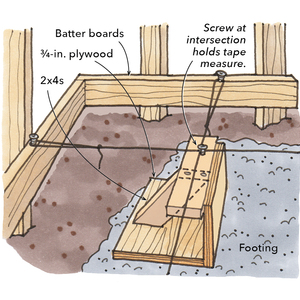I have removed Formica from some cabinet doors. How can I get the contact cement off the doors so that I can paint them?
Discussion Forum
Discussion Forum
Up Next
Video Shorts
Featured Story

A rear addition provides a small-scale example of how to frame efficiently.
Featured Video
How to Install Cable Rail Around Wood-Post CornersHighlights
"I have learned so much thanks to the searchable articles on the FHB website. I can confidently say that I expect to be a life-long subscriber." - M.K.
Fine Homebuilding Magazine
- Home Group
- Antique Trader
- Arts & Crafts Homes
- Bank Note Reporter
- Cabin Life
- Cuisine at Home
- Fine Gardening
- Fine Woodworking
- Green Building Advisor
- Garden Gate
- Horticulture
- Keep Craft Alive
- Log Home Living
- Military Trader/Vehicles
- Numismatic News
- Numismaster
- Old Cars Weekly
- Old House Journal
- Period Homes
- Popular Woodworking
- Script
- ShopNotes
- Sports Collectors Digest
- Threads
- Timber Home Living
- Traditional Building
- Woodsmith
- World Coin News
- Writer's Digest


















Replies
I'd use a heat gun and scraper, then sander
Welcome to the
Taunton University of Knowledge FHB Campus at Breaktime.
where ...
Excellence is its own reward!
Try heat first. If that doesn't work a paint remover likely will.
Contact cement is highly soluble in aromatic solvents like toluene or xylene; even gasoline will get to it. Just wet it with one of the above enough to soften and scrape it off with a scraper or putty knife or drywall knife, then use rags wet with T or X to remove the remaining glue.
Pay attention to ventilation and flammability, of course. Keep away from pilot lights and other flames and if you don't want a cheap high, get lots of air flow through your work area.
make sure you wear rubber gloves when you use xylene, it's nasty stuff.
Xylene will dissolve rubber, but nitrile gloves or chemical resistant gloves are good.
.BruceT
MEK
MEK (methyl ethyl ketone) has probably killed or sickened more aviation mechanics than anything. Many have died by using MEK in a jet's cockpit where there wasn't adequate ventilation, and the fumes overcame them. MEK would be my last resort.
What were they using mek for in a cockpit?
"When the spirits are low, when the day appears dark, when work becomes monotonous, when hope hardly seems worth having, just mount a bicycle and go out for a spin down the road, without thought on anything but the ride you are taking." — Sherlock Holmes, 1896
MEK has always been in the solvent inventory in the military. Nobody in the military ever read a MSDS. Fastidious crew chiefs would use it to remove oils and other such stuff in airplane cockpits, not realizing that the vapors settled in the cockpit. Sort of like carbon monoxide, they'd succomb to the vapors, pass out, and then die.
The best reference for a MEK related fatality was in the paper I found, listed below.
Do you have any references for the military fatalities other than anecdotal?? I would be very interested to read some detailed accounts.
DW has at times accused me of drinking all day when I've painted some cars with not enough attention to the respirator.
Fatal and non-fatal outcome by accidental intoxication with paint thinner
References and further reading may be available for this article. To view references and further reading you must purchase this article.A. M. TsatsakisView Image, a, View Image, G. Dolapsakisb, G. Troulakisc, P. Christodouloud, K. Relakise, N. Trikilisf and M. N. Michalodimitrakisf
a The Unit of Toxicology, University of Crete, Greece
Abstract
Although poisonings (fatal and non-fatal) due to intentional or accidental acute exposure to toluene or toluene mixture fumes have been previously reported in the literature, several issues concerning lethal doses or lasting post-exposure neuropathological impairments still remain unclear. Two male painters (18 and 30 years old) were accidentally exposed to toxic concentrations of paint diluent fumes containing toluene (TL), acetone (ACT) and methyl ethyl ketone (MEK) (60:15:15 w/w/w respectively) during their work in an underground reservoir. Both workers were found unresponsive by colleagues and were immediately transferred to the regional hospital. On admission, the younger man was pronounced dead, while the other remained in the intensive care unit for 3 days and then 4 days in the internal medicine ward. TL, ACT and MEK concentrations in blood samples taken from the survivor on admission were 6.3, 30.6 and 40.5 ëg/mL. Postmortem toxicology of the dead worker revealed TL, ACT and MEK blood levels of 12.4, 90.8 and 80.4 ëg/mL respectively. The solvent levels in the liver, kidney, lung, brain, testis and gland were also quantified and showed a somewhat similar distribution of the chemicals among these tissues with the highest levels found in the brain and the liver. The fatal and the non-fatal outcome that resulted despite similar intoxication conditions, most probably demonstrates the interindividual tolerance among the painters who also had similar body weights. The surviving painter did not develop any neuropsychological impairment in post-exposure time. The reported case strongly emphasizes the necessity to take precautions when using paint diluents in enclosed spaces.
Something's wrong with that article. MEK and acetone weigh only about 0.79g/mL and toluene weighs about 0.9g/mL, so there is no way there could have been 80g/mL or 30g/mL or even 6g/mL of any of those chemicals in someone's blood. I doubt if blood itself weighs more than about 1.2g/mL.BruceTEdit: Is that little box I see before the g supposed to be the symbol for micro, as in microgram?
Edited 10/11/2009 1:03 am by brucet9
Yes that is microgram... though it is displaying on my computer as 'ig' where it should be 'ug'.Here it is correctly displayed as 'ug'http://www.sciencedirect.com/science?_ob=ArticleURL&_udi=B6WHN-4D158T5-BN&_user=10&_rdoc=1&_fmt=&_orig=search&_sort=d&_docanchor=&view=c&_searchStrId=1043060666&_rerunOrigin=google&_acct=C000050221&_version=1&_urlVersion=0&_userid=10&md5=6d08200a659481a785983affca25fae8Wiki belowhttp://en.wikipedia.org/wiki/Microgrameasy to miss in the abstract that makes a huge difference
I'm curious about this as well. Used MEK unrestricted for nearly 20 yrs at the airline and never had an issue, although we were all (I think it was all of us) conscious of risks. MEK leaves no residual film so great for just prior to applying sealer and we sued to cut some of that selaer (PRC 1422 & 1435) for certain app on tank mods.
Read the chemical list of constituents in contact cement on the MSDS sheet... MEK. Ya already been exposed if you use contact cement.
The contact cement I've used for 50 years is not touched by plain mineral spirits.
Acetone works too, but not as well as MEK. Methyl chloride works also.
Just a little on a rag and rub off the contact cement.
In your warning post, did you mean cleaning fuel tanks vs. cockpits? Or did you mean MEK peroxide, which is really mean stuff (resin hardener) ?
The plastic hardener methyl ethyl ketone peroxide (MEKP) is an unstable peroxide that releases free oxygen radicals. Ingestion of this compound induces widespread liver necrosis that is often fatal, extensive ulceration with subsequent scarring, and stenosis of the proximal digestive tract in survivors.
Methyl ethyl ketone is used as a solvent. Acute (short-term) inhalation exposure to methyl ethyl ketone in humans results in irritation to the eyes, nose, and throat. Limited information is available on the chronic (long-term) effects of methyl ethyl ketone in humans. Chronic inhalation studies in animals have reported slight neurological, liver, kidney, and respiratory effects. No information is available on the developmental, reproductive, or carcinogenic effects of methyl ethyl ketone in humans. Developmental effects, including decreased fetal weight and fetal malformations, have been reported in mice and rats exposed to methyl ethyl ketone via inhalation and ingestion. EPA has classified methyl ethyl ketone as a Group D, not classifiable as to human carcinogenicity. (from EPA)
Edited 10/10/2009 10:54 am ET by junkhound
I believe regular ol' paint thinner will disolve it. If you have some laying around (and who doesn't?), give it a shot. Can't hurt to try it.
~ Ted W ~
Cheap Tools! - MyToolbox.net
See my work at TedsCarpentry.com
Edited 10/10/2009 1:22 am by Ted W.
Weldwood sells a contact cement remover.
HD used to sell contact cement thinner, but maybe no longer. IIRC it was a mixture of xylene and toluene, as one of the other posters suggested.
Scott.
Just as junkhound has said. Lacquer thinner or acetone.
I've delaminated many a sheet with this stuff due to operator/application error.